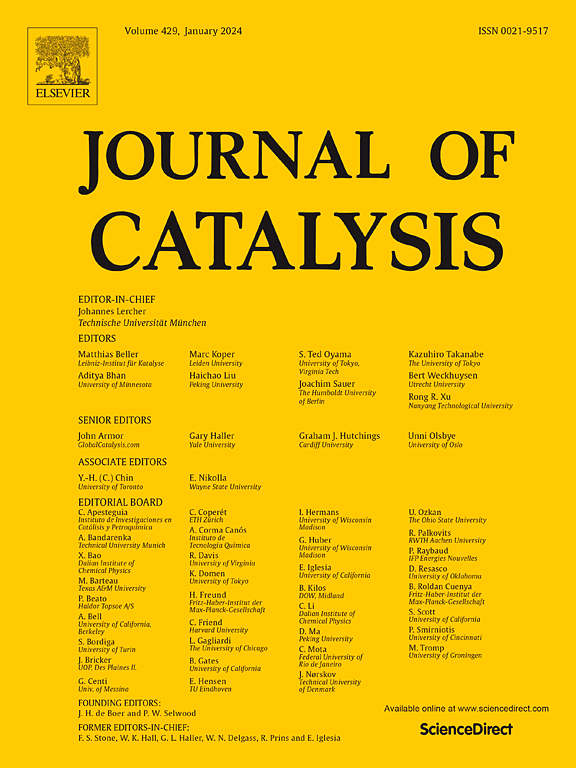Simultaneous boosting visible light-driven benzene hydroxylation reaction rate and phenol selectivity via a novel monolithic polymer photoreactive composite based on N-doped TiO2 supported CuO
IF 6.5
1区 化学
Q2 CHEMISTRY, PHYSICAL
引用次数: 0
Abstract
A novel photoreactive composite consisting of CuO-loaded N-doped TiO2 (CuNdT) embedded in a syndiotactic polystyrene (sPS) monolithic aerogel was developed and evaluated for the photocatalytic hydroxylation of benzene to phenol under visible light irradiation. The process was identified as biphasic, where the photoreaction occurred within the solid phase of the composite, and the surrounding liquid phase acted as a reservoir for the desired product (phenol). The composite was extensively characterized through WAXD, SEM, BET, and tomographic analyses, confirming the uniform dispersion of CuNdT particles within the porous, hydrophobic sPS matrix. Under acidic conditions (pH = 2), the composite achieved 96 % benzene conversion and >99 % phenol selectivity within 180 min of irradiation, results that surpass those reported in the literature for visible-light-driven benzene hydroxylation. Kinetic modeling, based on experimentally determined partition coefficients for benzene and phenol, revealed that the composite operated entirely in a chemical regime, free from diffusional limitations. The calculated efficiency factors, all equal to 1, confirmed that the reaction was controlled solely by chemical processes occurring on the CuNdT dispersed inside the sPS matrix. The differences in kinetic constants between pH = 7 and pH = 2 highlighted the critical role of pH in driving the photocatalytic process. At pH = 2, the increased tendency of H2O2 to form hydroxyl radicals enhanced the rates of benzene consumption and phenol formation. Additionally, the higher affinity of benzene for the hydrophobic sPS polymer matrix at acidic pH, as reflected by its elevated partition coefficient, further facilitated its interaction with the composite, promoting faster oxidation. In contrast, phenol displayed a lower affinity for the hydrophobic sPS matrix at pH = 2, as evidenced by its lower partition coefficient, allowing it to remain in the liquid phase, reducing over-oxidation and contributing to the higher phenol yield (96 %) observed at acidic pH. This synergistic effect between enhanced hydroxyl radical generation, increased benzene affinity and reduced phenol affinity led to a more efficient photocatalytic process under acidic conditions. These findings establish CuNdT/sPS as a highly efficient, selective, and robust photocatalytic material, combining superior performance, structural stability, and excellent reusability for multiple reaction cycles.


基于n掺杂TiO2负载CuO的新型单片聚合物光反应复合材料同时提高可见光驱动苯羟基化反应速率和苯酚选择性
制备了一种新型光反应复合材料,该复合材料由负载cuo的n掺杂TiO2 (CuNdT)包埋在共规聚苯乙烯(sPS)单片气凝胶中,并对其在可见光下光催化苯羟基化制苯酚进行了研究。该过程被确定为双相,其中光反应发生在复合材料的固相中,而周围的液相则充当所需产物(苯酚)的储存库。通过WAXD, SEM, BET和层析分析对该复合材料进行了广泛的表征,证实了CuNdT颗粒在多孔疏水性sPS基体中的均匀分散。在酸性条件下(pH = 2),该复合材料在180 min的辐照时间内,苯转化率达到96% %,苯酚选择性达到99% %,超过了文献报道的可见光驱动苯羟基化反应的结果。基于实验确定的苯和苯酚分配系数的动力学模型显示,该复合材料完全在化学体系中运行,不受扩散限制。计算出的效率因子均为1,证实该反应完全由分散在sPS基质内的CuNdT上发生的化学过程控制。pH = 7和pH = 2之间的动力学常数差异突出了pH在驱动光催化过程中的关键作用。在pH = 2时,H2O2形成羟基自由基的倾向增加,提高了苯的消耗和苯酚的生成速度。此外,在酸性pH条件下,苯对疏水sPS聚合物基质具有较高的亲和力,其分配系数升高,进一步促进了其与复合材料的相互作用,促进了更快的氧化。相比之下,苯酚在pH = 2时对疏水性sPS基质的亲和力较低,这可以从其较低的分配系数中得到证明,这使得它能够留在液相中,减少过度氧化,并有助于在酸性pH下观察到更高的苯酚收率(96% %)。这种增强羟基自由基生成,增加苯亲和性和降低苯酚亲和性之间的协同作用导致在酸性条件下更有效的光催化过程。这些发现表明,CuNdT/sPS是一种高效、选择性和强大的光催化材料,具有优异的性能、结构稳定性和多次反应循环的可重复使用性。
本文章由计算机程序翻译,如有差异,请以英文原文为准。
求助全文
约1分钟内获得全文
求助全文
来源期刊

Journal of Catalysis
工程技术-工程:化工
CiteScore
12.30
自引率
5.50%
发文量
447
审稿时长
31 days
期刊介绍:
The Journal of Catalysis publishes scholarly articles on both heterogeneous and homogeneous catalysis, covering a wide range of chemical transformations. These include various types of catalysis, such as those mediated by photons, plasmons, and electrons. The focus of the studies is to understand the relationship between catalytic function and the underlying chemical properties of surfaces and metal complexes.
The articles in the journal offer innovative concepts and explore the synthesis and kinetics of inorganic solids and homogeneous complexes. Furthermore, they discuss spectroscopic techniques for characterizing catalysts, investigate the interaction of probes and reacting species with catalysts, and employ theoretical methods.
The research presented in the journal should have direct relevance to the field of catalytic processes, addressing either fundamental aspects or applications of catalysis.
 求助内容:
求助内容: 应助结果提醒方式:
应助结果提醒方式:


